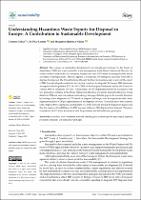Por favor, use este identificador para citar o enlazar este ítem:
https://repositorio.usj.es/handle/123456789/601
Registro completo de metadatos
| Campo DC | Valor | Lengua/Idioma |
|---|---|---|
| dc.contributor.author | Callao, Carmen | - |
| dc.contributor.author | Latorre, M. Pilar | - |
| dc.contributor.author | Martínez-Núñez, Margarita | - |
| dc.date.accessioned | 2021-09-10T12:03:31Z | - |
| dc.date.available | 2021-09-10T12:03:31Z | - |
| dc.date.issued | 2021-08-09 | - |
| dc.identifier.citation | Callao, C.; Latorre, M.P.; Martinez-Núñez, M. Understanding Hazardous Waste Exports for Disposal in Europe: A Contribution to Sustainable Development. Sustainability 2021, 13, 8905. https:// doi.org/10.3390/su13168905 | es_ES |
| dc.identifier.issn | 2071-1050 | es_ES |
| dc.identifier.uri | https://repositorio.usj.es/handle/123456789/601 | - |
| dc.description.abstract | The concept of sustainable development was introduced in Europe by the Treaty of Amsterdam (1997) and was extended to waste management in the Waste Framework Directive. In order to achieve sustainable development, hazardous waste (HW) must be managed safely and in accordance with regulations. This also applies to worldwide HW transport, especially when HW is shipped for disposal. The United Nations, through the Basel Convention, aims to prevent the export of HW from developed countries to developing countries for disposal. In Europe, HW shipments are regulated by Regulation (EC) No. 1013/2006 of the European Parliament and by the Council of 14 June 2006 on shipments of waste. Additionally, all HW shipments must be in accordance with two principles contained in the Waste Framework Directive: proximity and self-sufficiency. Using data from 2014 and network analysis methodology, this paper fills the gaps in the scientific literature by looking at how shipments of HW travel for disposal in Europe, how the regulations affect these shipments and how GDP per capita influences the shipment of waste. The results show that countries with a high GDP per capita play an important role in the network (having the highest in-degree) and that the absence of landfill taxes for HW does not influence HW shipments for disposal. Therefore, countries in the EU act in accordance with the proximity and self-sufficiency principles. | es_ES |
| dc.format.mimetype | application/pdf | es_ES |
| dc.language.iso | eng | es_ES |
| dc.publisher | MDPI AG | es_ES |
| dc.relation.requires | Adobe PDF | es_ES |
| dc.rights | Attribution-NonCommercial-NoDerivatives 4.0 Internacional | * |
| dc.rights | Atribución 4.0 Internacional | * |
| dc.rights.uri | http://creativecommons.org/licenses/by/4.0/ | * |
| dc.subject | Hazardous waste shipment | es_ES |
| dc.subject | Network analysis | es_ES |
| dc.subject | Gross domestic product per capita | es_ES |
| dc.subject | Disposal | es_ES |
| dc.subject | Proximity principle | es_ES |
| dc.subject | Self-sufficiency principle | es_ES |
| dc.title | Understanding hazardous waste exports for disposal in europe: A contribution to sustainable development | es_ES |
| dc.type | journal article | es_ES |
| dc.relation.publisherversion | https://www.mdpi.com/2071-1050/13/16/8905 | es_ES |
| dc.identifier.publicationfirstpage | 1 | es_ES |
| dc.identifier.publicationlastpage | 14 | es_ES |
| dc.identifier.doi | 10.3390/su13168905 | es_ES |
| dc.rights.accessRights | open access | es_ES |
| Aparece en las colecciones: | Artículos de revistas | |
Ficheros en este ítem:
| Fichero | Descripción | Tamaño | Formato | |
|---|---|---|---|---|
| Understanding hazardous waste exports for disposal in europe.pdf | 1,5 MB | Adobe PDF |  Visualizar/Abrir |
Este ítem está sujeto a una licencia Creative Commons Licencia Creative Commons

